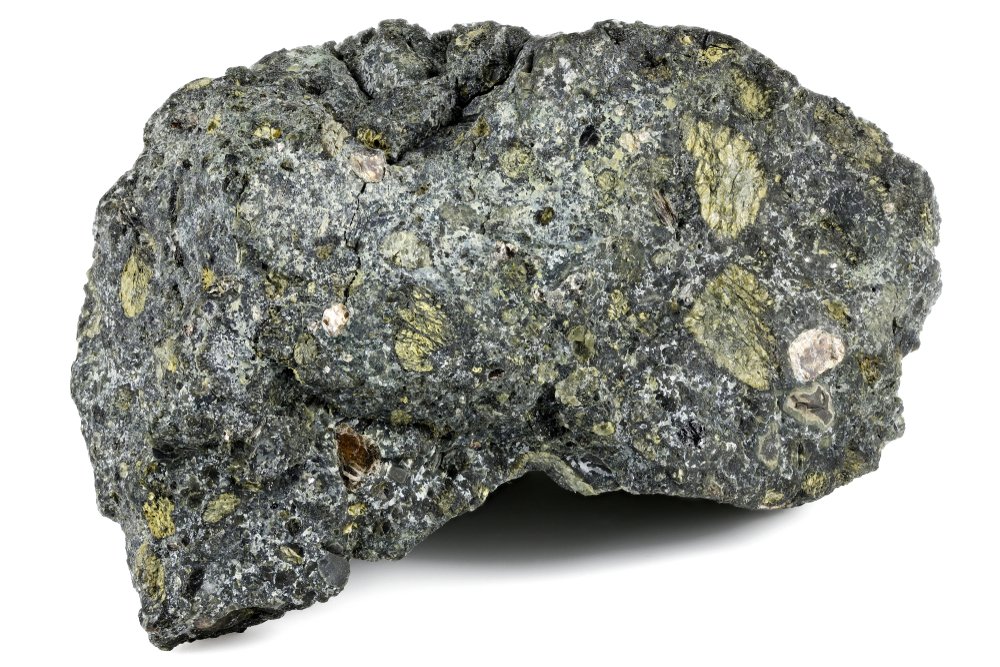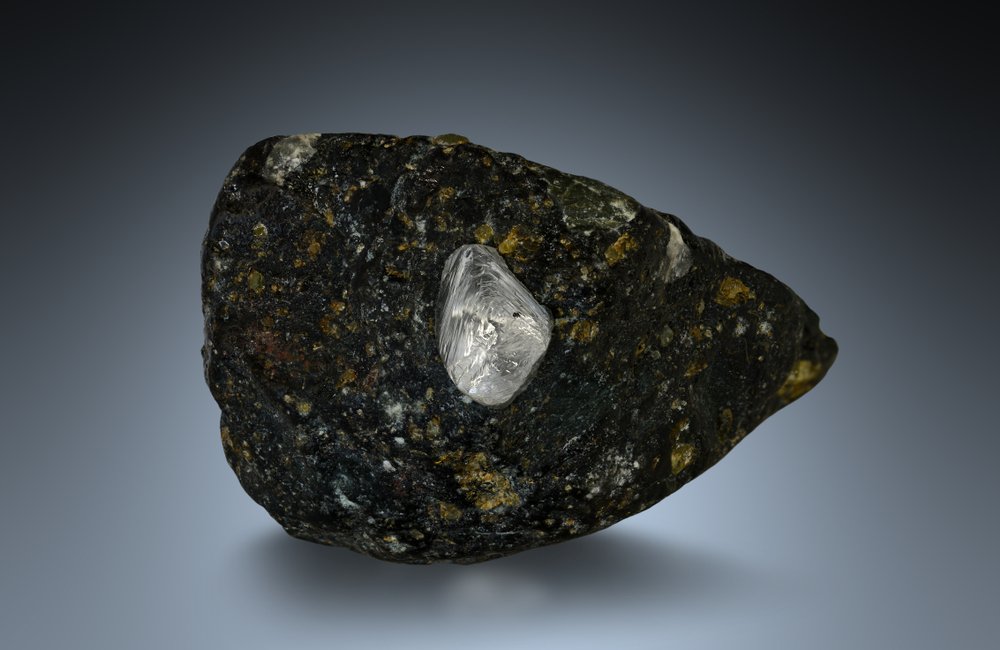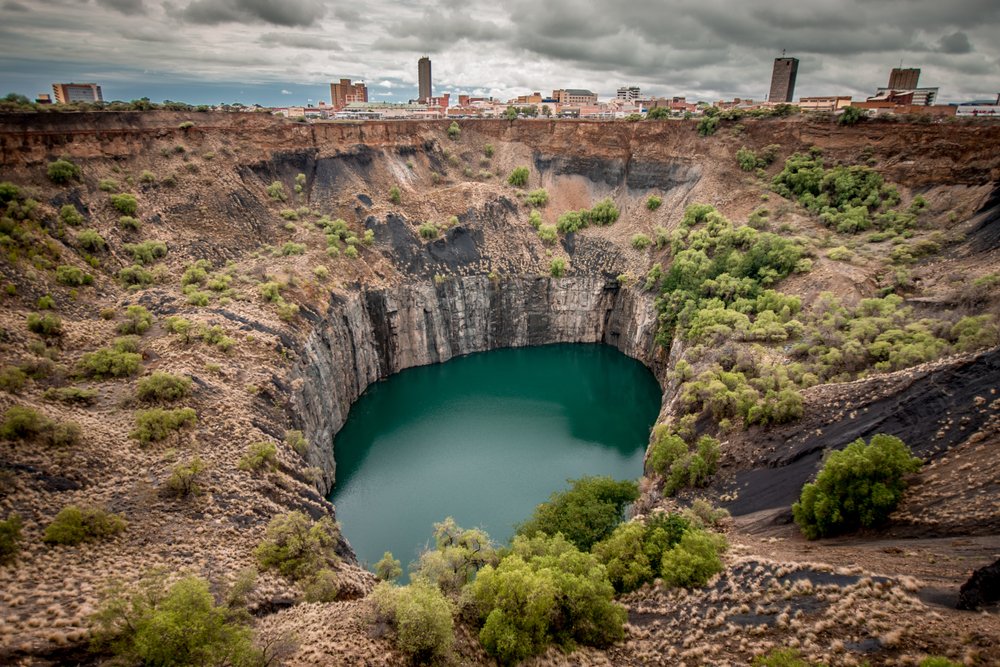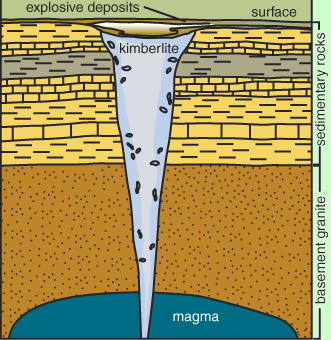Kimberlite is a strange rock from deep within the earth. It’s also the main source of diamonds, and its unusual characteristics lend it to studies that help us learn more about the earth. Kimberlite is a true oddity, although it’s not entirely uncommon on our planet.
So, let’s sit down and learn a bit about kimberlite, including what it is, how it forms, and why they contain diamonds!
What is Kimberlite?
Kimberlite is a blue-ish rock that’s found almost exclusively in structures known as kimberlite pipes. Kimberlite itself is an igneous rock, and is considered a rare variant of peridotite. Those who are familiar with the formation of peridot know that peridotite is an olivine-rich stone that bears the semi-precious gemstone peridot.

As a rock, rather than a single mineral, the chemical makeup of kimberlite varies. In general, it’s high in magnesium and potassium minerals, while low in silica.
Kimberlite that is on the surface is often yellow in color. This is due to deposits of limonite that occur on kimberlite during natural weathering. In diamond mining, this is referred to as “yellow ground.” This weathered stone at the surface breaks apart fairly easily, so its generally mined for diamonds before deeper excavations take place.
Kimberlite which hasn’t been exposed to weathering, on the other hand, is known as “blue ground.” The blue ground is much harder and tougher, requiring machinery to force it to give up its diamonds.
Kimberlite doesn’t form like many rocks do, as layers in the crust over a location. Instead, kimberlite is known to form kimberlite pipes. These pipes are evidence of volcanic activity and are actually remnants of a sort of volcano.
These structures aren’t overly rare, there are over six thousand of them identified on the planet so far, but only 900 of them hold a considerable amount of diamonds. Of these, 30 are considered to be commercially viable as diamond mines.

How Kimberlite Got It’s Name
Kimberlite is named after the town of Kimberley in South Africa, where it was first identified after the stone that would become the Star of South Africa was discovered. This led to the South African diamond rush and the eventual creation of an enormous open pit mine.
The mine itself came to be called the Big Hole because… well, it’s an enormous hole in the ground. It was originally dug by hand and it’s often claimed to be the world’s largest hand-dug hole.
Kimberlite is mainly known for occurring with diamonds and other gemstones locked inside, but their creation is just as interesting as the gems that kimberlite yields.

How Do Kimberlite Pipes Form?
Kimberlite pipes are a true oddity in the world of geology.
Most of the minerals and gemstones that are pulled from the Earth come from the crust. The crust makes up about 1% of the outer volume of the planet, and in this relatively shallow area we find everything that we’ve used to create the world around us.
Underneath the crust lies the mantle. The mantle of the Earth is thought to be solid stone of some type, but under the intense pressure and heat from the weight above it, it flows slowly over geological time scales. This deforms the crust, creating geological features like mountains.
Kimberlite originates in the upper portion of the mantle, and it is one of the few stones that do so. Kimberlite “pipes” are actually shaped a bit like a carrot, widening at the top. The pipes are the remnants of ancient, deep volcanos. The source of kimberlite lies almost 300% deeper in the Earth than most volcanoes.

This magma doesn’t just contain minerals, it also contains things like carbon dioxide and water. These elements are volatile, expanding as the magma rises and the pressure on them lowers.
The result? An explosion of volcanic debris, ash, and gasses at supersonic speeds.
Kimberlite pipes don’t build a volcano like most eruptions. Instead, they form a ring of circling hills around the new depression, called a tuff ring. In the case of kimberlite, this material often erodes back into the center of the ring over time, leaving the ground mostly flat again.
Kimberlite pipes are plugs over the subterranean magma dike that supplied them in the first place. As they cool the remaining material forms kimberlite, and if the conditions are right it will contain diamonds.
Kimberlite Pipes Can Be Difficult to Locate
Exploration to find kimberlite pipes can be extensive. The problem is that kimberlite readily weathers when present on the surface of the earth and kimberlite pipes don’t have the same surrounding mountain that we see with most volcano types. Where present it may be covered in soil, vegetation, and debris as well.
These days, high-tech methods are used to find areas that may contain kimberlite before foot exploration occurs. For much of human history diamonds were incredibly rare, but as technology has advanced so have our methods of finding them and processing the host kimberlite.
Why Do Kimberlites Contain Diamonds?
As most of us know, diamonds are carbon that’s been compressed and heated to an extreme degree. They generally form in the upper parts of the mantle, where the intense pressure and heat required for their natural growth is present.
When a kimberlite pipe explodes, it drags material up with it from the mantle. Kimberlite, as noted above, is a pretty rough rock that contains many different minerals in particles of various sizes.
Most diamonds found in kimberlite are at least 1 billion years old, and some have been dated at three times that! The mantle has enough heat and pressure that the diamonds formed are able to stay in place indefinitely, even on a geological time scale.
While the common myth is that diamonds are formed from coal, and this may happen in some subduction zones, it’s not likely. Coal is derived from the remnants of living things and the depth at which diamonds form makes it unlikely. Instead, they’re most likely formed from various carbonate-containing minerals.
Instead, it’s thought that the magma which makes up kimberlite is less oxidizing than other, more common, types of magma. This, combined with the high speed of kimberlite pipes during formation, allows the diamonds to remain undissolved despite the incredible heat.
In other words: the magma that forms kimberlite and the manner in which kimberlite pipes are formed make it one of the few mediums through which diamonds can be transported. Without the oddities present in the magma, the right location, and the presence of diamonds there would be few, if any at all, to be found.
- Online rock and mineral club for collectors of all levels!
- Find community with like-minded rock and mineral enthusiasts.
- Monthly Giveaways!
- Free Access to Entire Digital Library of Products (current and future products)*


